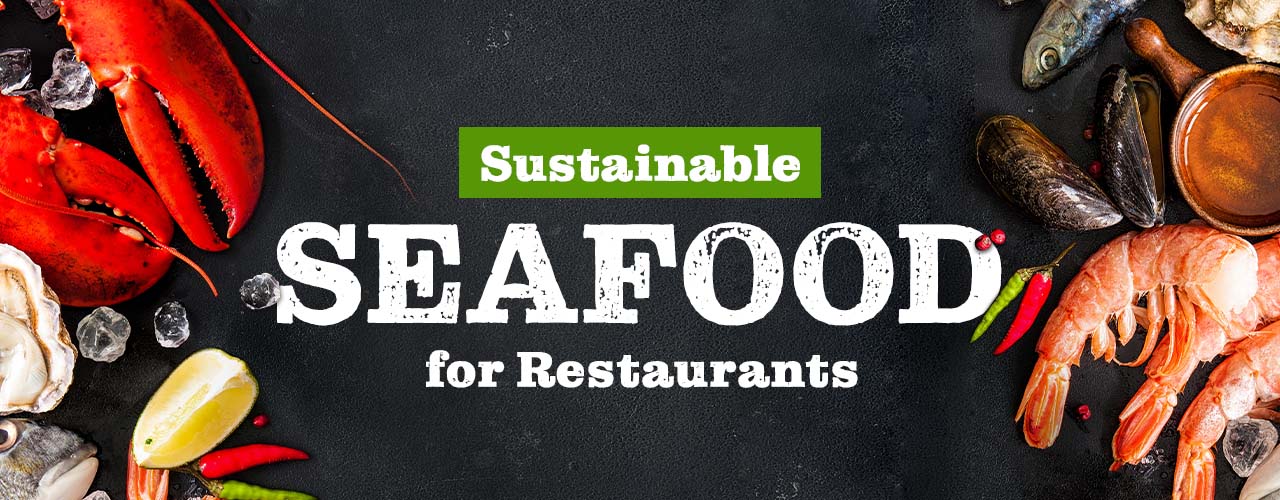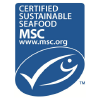
Whether it’s related to food sourcing or disposal methods, sustainability has been at the forefront of foodservice trends and concerns in recent years. One of the primary focuses of the sustainability movement is the health of our oceans and marine life. Over 50% of American consumers identified that sustainable seafood is important to them and that they would pay more for it to help the environment. If your seafood restaurant is looking for greener practices, we’ve collected some seafood sustainability tips that your business can incorporate into your menu this year.
Shop All SeafoodWhat Is Sustainable Seafood?
Sustainable seafood is any fish or shellfish that is caught for consumption in a way that doesn’t threaten its ecosystem or the stability of the species. The way the fish is raised, harvested, or wild-caught must be renewable and cannot jeopardize the future population of that particular species. The fishing method also cannot over-pollute the environment in which the species lives.
Popular Seafood
Seafood is a great source of Omega-3 fatty acids, vitamins A, B, and D, which makes it a staple on various menus around the world. Even with the nutritional benefits, most Americans only enjoy 5-10 varieties of seafood, which can lead to overfishing of those species and unsustainable harvesting practices. Below are the most popular seafood varieties consumed by the global population:
Unsustainable Fishing Practices
Fish are harvested for foodservice markets using two distinct methods: wild caught fishing and aquaculture. Both methods can have negative impacts on the environment if not regulated and improved. Without instilling sustainable practices, fisheries are expected to collapse as early as 2050. It is important to take these practices under consideration when selecting seafood types and suppliers for your restaurant.
Wild Caught Fishing

Wild caught fishing can easily turn unsustainable when companies are overfishing and producing bycatch on their fishing lines and nets. Keep reading for more information on how wild caught fishing can damage the environment and how it can be made more sustainable.
- Overfishing - Overfishing occurs when mature fish are collected from the ocean faster than the population can reproduce. This can lead to the extinction of a wildly occurring fish population and put pressure on fish hatcheries to make up for the loss to keep up with demand.
- Bycatch - The term bycatch classifies marine life that is unintentionally caught on fishing lines and in fishing nets along with the target species. Bycatch may include dolphins, sea turtles, sharks, other fish species, and even the wrong size of the target species. If bycatch is not removed from the nets, the animals can die, making open-sea fishing unsustainable to the environment. Wild caught fishing produces about 7 million tons of bycatch a year, with most of a fisherman's catch being bycatch instead of the target fish.
- Ghost Nets - Ghost nets are fishing nets that are either lost or left behind by fishing boats. The nets continue to trap and entangle sea creatures as they float in the ocean, causing unnecessary loss of life. It is estimated that there are currently 640,000 tons of ghost fishing nets polluting our oceans.
Can Wild-Caught Fish Be Sustainable?
Although wild caught fishing can be damaging to the ecosystem, there are actions fishermen can take to make the practice more sustainable.
- To reduce overfishing, fishing companies can follow organizations that research and regulate fish populations to learn which species they should avoid in that season or location.
- To reduce bycatch, fishing companies can choose selective fishing practices like harpooning, hook and line fishing, and certain traps over bottom trawls and long lines.
- To reduce ghost nets, fishing companies should try to keep track of their fishing nets and attempt to retrieve them if they come loose. They can also choose fishing gear contact information and tag identifiers so that they can be traced back to the owner if lost. Ocean cleanup organizations also work hard to remove ghost nets from the ocean and recycle them.
Aquaculture (Farm-Raised Fish)
While many believe that farmed fish provide the most eco-friendly seafood option, this is not always true. Although aquaculture is a great way to boost fish supplies, it can turn unsustainable quickly if not done correctly.
- Waste - Farm-raised fish produce a considerable amount of waste, including uneaten feed and excrement that can build up in their enclosures or pollute the habitat in which they are raised. This can lead to increased nitrogen levels, toxic algae blooms, and disease in the fish population if not filtered correctly.
- Chemical Usage - Some aquacultures use certain chemical hormones as growth enhancers, like methyltestosterone, that increase the size and growth rate of a fish population. This changes the genetics of the fish and can have harmful effects on humans, like liver toxicity, when the fish is consumed.
- Unsustainable Feed Ingredients - If aquaculture farmers are using wild-caught forage fish to feed their farm-raised fish, then they are depleting the population from the natural ecosystem and causing other species to suffer. If aquaculture fish are put on an entirely plant-based diet, then fisheries must consider the carbon footprint caused by land farming.
- Containment Issues - Fish that are raised in an aquaculture system are genetically different from those in the wild. If a farm-raised fish escapes from its enclosure, it can end up reproducing and mutating the wild population, which will upset the natural ecosystem.
Can Farm-Raised Fish Be Sustainable?
With some modifications and effort, fish farms can become a sustainable option for the future of seafood.
- To reduce waste pollution, companies should take advantage of natural filtration methods like using seaweed and bivalves to reduce the waste that is able to run downstream. They should also implement thorough filtration and waste disposal plans for their facility.
- To reduce chemical usage, fish farms should use biosecurity management methods and early diagnosis to detect changes and diseases in the fish population. They should also avoid using antibiotics as a grown enhancer that can mutate the genetics of the fish.
- To reduce the use of unsustainable feed ingredients, fish farmers can switch to natural and balanced fish feed made with microalgae, seaweed, insects, microbes, nuts, and some forage fish.
- To reduce containment issues, companies keep their fish separate from the wild ecosystem, by using secure enclosures and regularly checking their enclosures and nets for damage.
How to Run a Sustainable Seafood Restaurant
Most customers will associate locally sourced products with sustainability, but that isn't always the case for fish and other seafood. Seafood sustainability comes down to how the fish was raised and harvested, along with the proximity of the water source. We’ve prepared a list of actions you can take to ensure that your seafood restaurant works towards becoming a more sustainable business. Through sourcing and menu changes, you can reduce your impact on our oceans.
1. Look For Sustainable Suppliers

When choosing a supplier for your seafood restaurant, you’ll want to pick one that prioritizes sustainability with its product. To narrow down your choices, ask suppliers the following questions to ensure that they are taking the appropriate measure to provide eco-friendly seafood options:
- Are they part of a trusted sustainability certification program?
- What is their preferred fishing method? What sustainability practices are they using in that method?
- If wild-caught, how do they reduce bycatch? What research are they doing to choose which species and location to target without greatly impacting the fish population?
- If farm-raised, what do they feed their fish? How do they treat disease? How do they handle the waste that is produced?
- What are their sustainability goals and how can you help them achieve those goals?
You’ll want to select a supplier who is transparent about their fishing practices and sustainability goals, and one that is familiar with current fishing policies so you can in turn serve your customers environmentally friendly seafood options. You can also look up fishers and suppliers on ocean advocate websites to see how they rank.
2. Make Menu Changes
A major factor in becoming a restaurant with sustainable seafood is making menu changes. Choosing seafood options that are less in demand than traditional selections is a great way to reduce your environmental impact. Below are some ways that you can make your seafood menu more environmentally friendly:
Serve Trash Fish
Invasive and unpopular fish species, also known as “trash fish”, provide a great alternative to species like salmon, tuna, and swordfish that are being overfished. Here are some trash fish alternatives you can choose that would still be delicious on a menu:
- Pollock
- Triggerfish
- Lionfish
- Sheepshead Fish
- Sea Robin
- Whiting
- Mackerel
- Anchovies
- Sardines
Serve Seasonal Fish
Just like vegetables have a growing season, fish populations also fluctuate with seasons and location. The sites Seafood Watch and FishWatch.gov can give you an understanding of which species are thriving during the current season and which are depleted based on your region so you can easily make sustainable menu adjustments.
For example, the Pacific salmon season begins in the spring on the West Coast. Striped bass is in abundance on the East Coast during the summer, while albacore tuna is in season during the summer on the West Coast. Peconic bay scallop season begins in the fall on the East Coast and winter is a great time for Dungeness crabs on the West Coast.
Serve Vegan Alternatives
You can expand your seafood menu by offering seafood options that aren't made with fish at all. If you’re looking to become vegan-friendly or make more sustainable choices, vegan seafood is a great substitute for your restaurant. Vegan seafood is made to imitate the look, taste, and texture of fish by using all plant-based ingredients. You can find vegan salmon and tuna sashimi, shrimp, and calamari made with natural ingredients like tapioca starch and kelp or seaweed extract.
3. Check for Fish Certification Labels When Shopping
When looking for high-quality and sustainable stock for your seafood restaurant, it's important to look for sustainable seafood certifications on packaging or display cases. Eco-certified seafood labels mean that the product was raised or caught in eco-friendly and sustainable conditions that meet the standards required by the certification. You can list these logos on your menu next to certified ingredients as a selling point for customers. Keep reading to become familiar with the leading seafood certifications in the foodservice industry.
Sustainable Seafood Certifications
The following are some of the top sustainable fish certifications to look for when picking seafood products for your restaurant.
- ASC Certified - The Aquaculture Stewardship Council certification provides strict guidelines for farm-raised seafood that are socially and environmentally responsible.
- GLOBALG.A.P. Certified - The Global Good Agricultural Practices certification has strict criteria for animal welfare, legal compliance, environmental care, and supply chain transparency in aquaculture settings.
- RSPCA Assured - The assured certification by the Royal Society for the Prevention of Cruelty to Animals indicates that a salmon or trout product was raised in aquaculture according to their high standards for animal welfare and humane treatment.
- Quality Trout UK Assured - The assured certification by Quality Trout UK guarantees that a trout product was raised and harvested following the high standards of the program to ensure humane treatment in trout aquaculture settings.
- Friend of the Sea Certified - The Friend of the Sea certification ensures that fisheries and aquaculture upheld the proper treatment of a species and used responsible fishing practices to protect natural resources.
- Marine Stewardship Council Certified - The Marine Stewardship Council certification provides benchmarks for wild-caught fisheries to meet that ensure their catch is traceable and sustainable.






You can find some seafood products that do not fall under a particular sustainable certification, but rather are broadly recognized as eco-friendly alternatives, including muscles, clams, and kelp. These options are used for their restorative aquacultural effects on marine ecosystems, such as providing natural water filtration. By adding them to your menu, your business helps support sustainable efforts indirectly.
4. Work with Your Neighbors to Find Sustainable Options
If you’re striving to take steps towards offering sustainable seafood, it can be very helpful to ask your neighboring restaurant owners for advice and potentially work together to reach a common goal. Here are some seafood sustainability questions you can ask other restaurants:
- Do they use sustainable seafood suppliers? Which suppliers?
- Are they part of any sustainable seafood organizations or fishery programs?
- Would they be interested in joining together to reach purchase volumes with sustainable suppliers?
- Are they familiar with any additional actions you could take or local organizations you can join to reach your sustainability goal?
5. Share Your Efforts with Your Customers
As food trends progress, it is clear that customers are attracted to sustainable choices. Approximately 50% of consumers say they will support sustainable seafood options if they are available, and they are even willing to pay more for them. A great way to boost your sustainability efforts is by being open and transparent with your customers about your menu choices and suppliers.
By listing a menu option as “sustainably sourced seafood”, customers will be more likely to order it and help you boost your bottom line to continue financing your sustainable goals. Train your servers to be able to answer questions on where and how your fish and seafood options were sourced and what efforts your business is taking to be more environmentally friendly to our oceans. List the sustainable certifications of your ingredients to help your customers easily identify eco-friendly meal options.
Benefits of Serving Sustainable Seafood

Offering sustainable seafood in your restaurant can bring positive impacts to your business and the environment. Here are some of the benefits of serving sustainable fish on your menu:
- Customers are looking for sustainable choices and will pay more for them
- Decreased pollution on land and in the oceans
- Healthier fish population in the oceans to support the food chain
- Reduced risk of species extinction
By choosing sustainable options for your restaurant, you can be part of the movement to provide a safer and healthier planet for generations to come. Use this guide to incorporate sustainable seafood in your recipes and support ocean health with your business.





